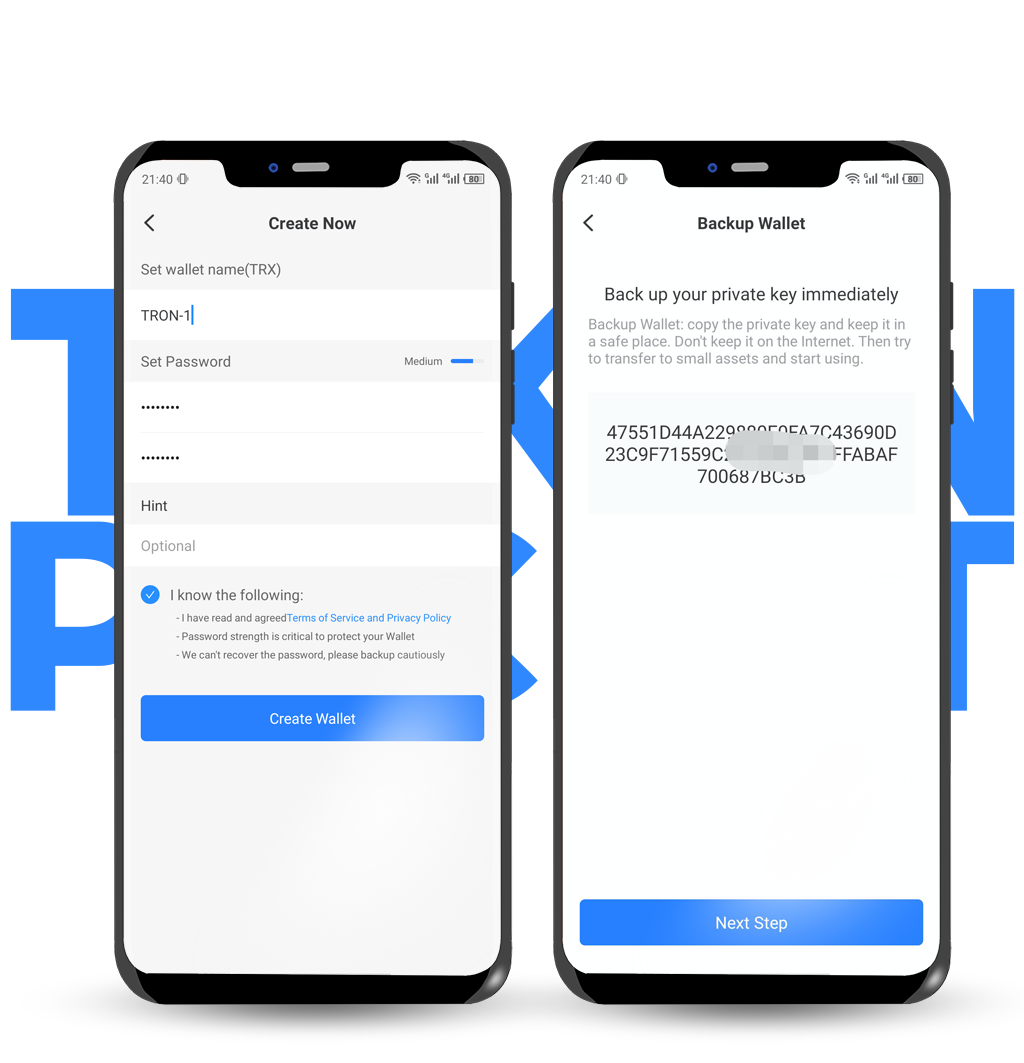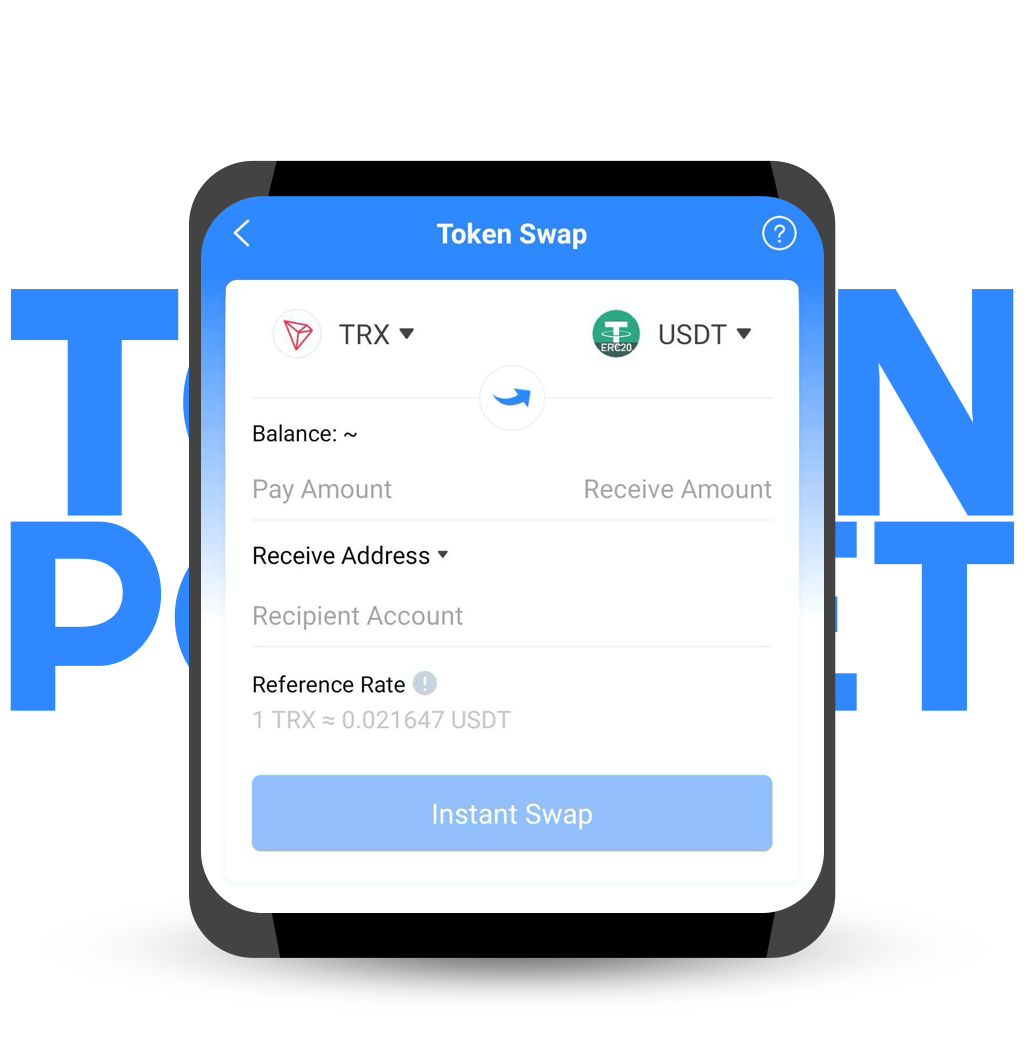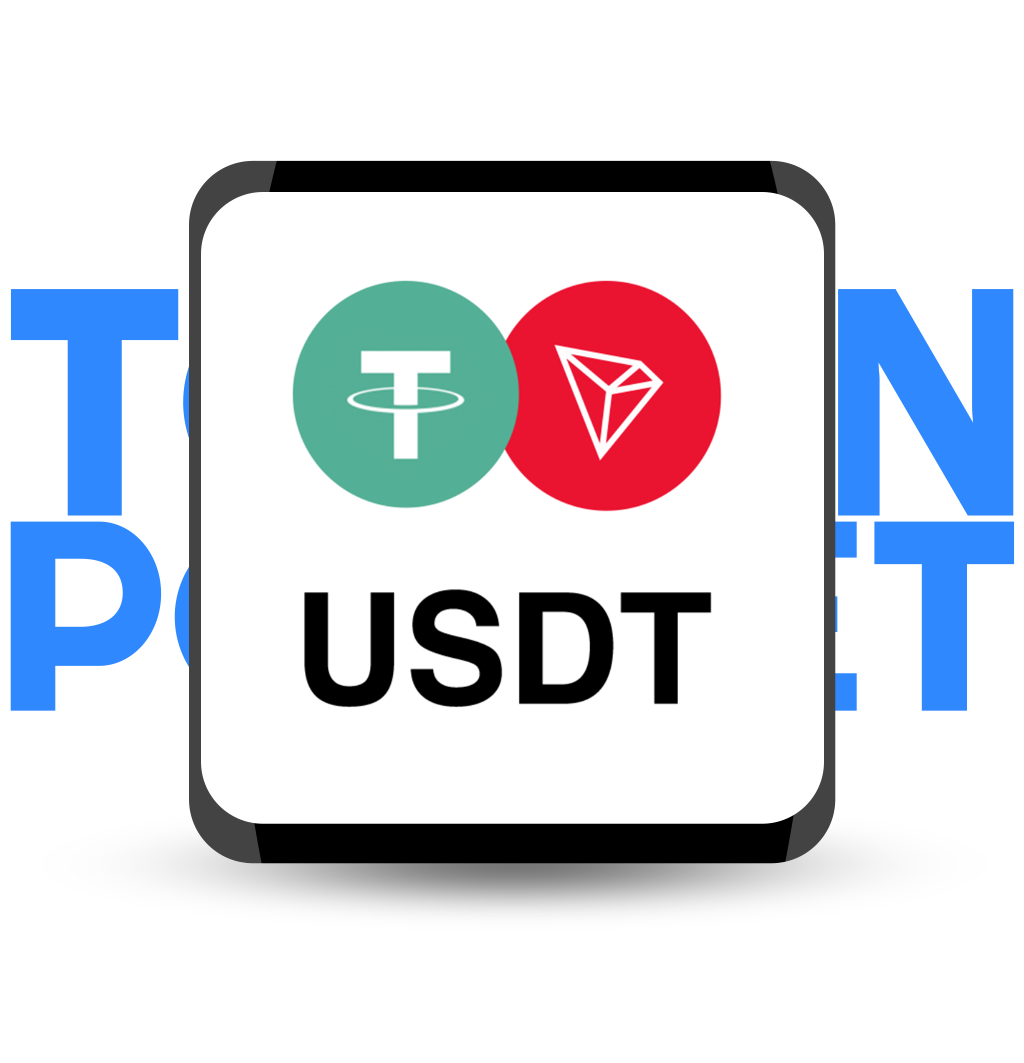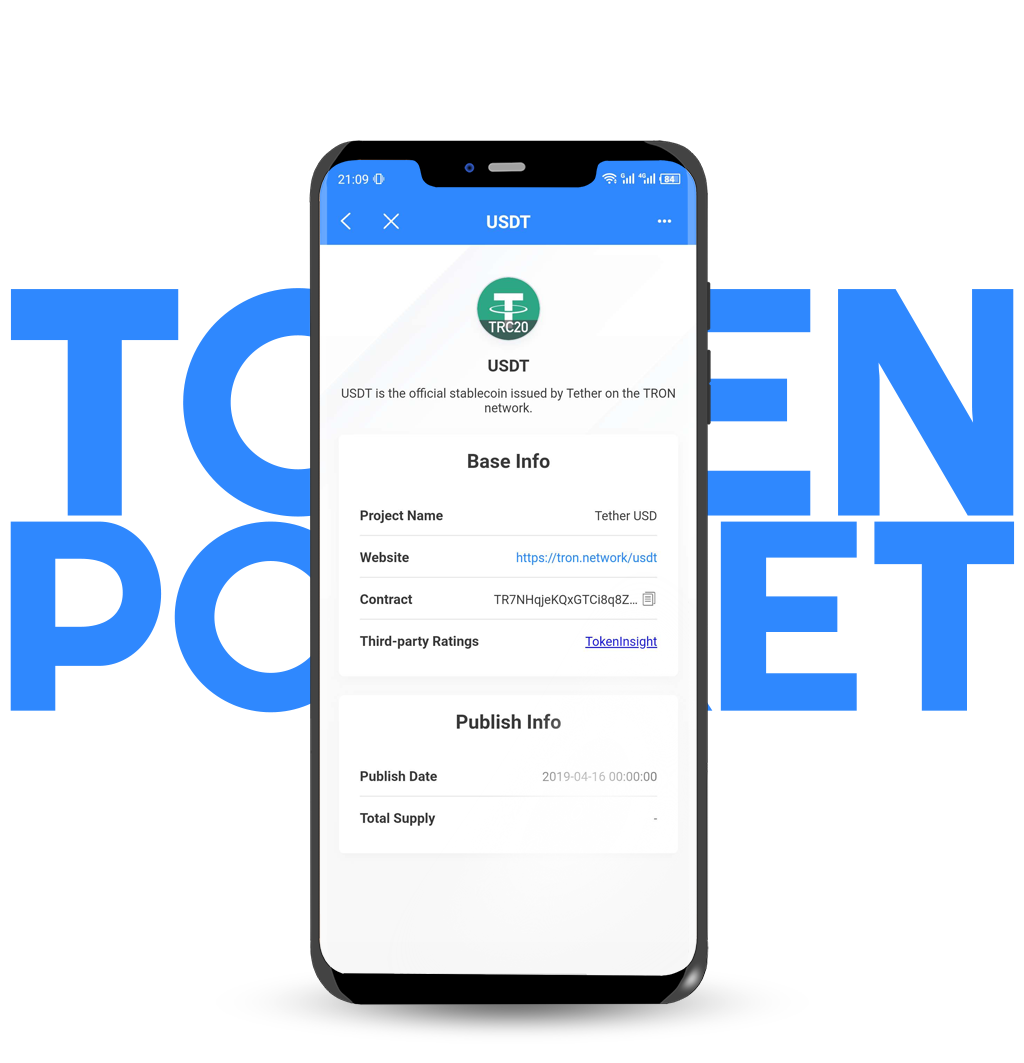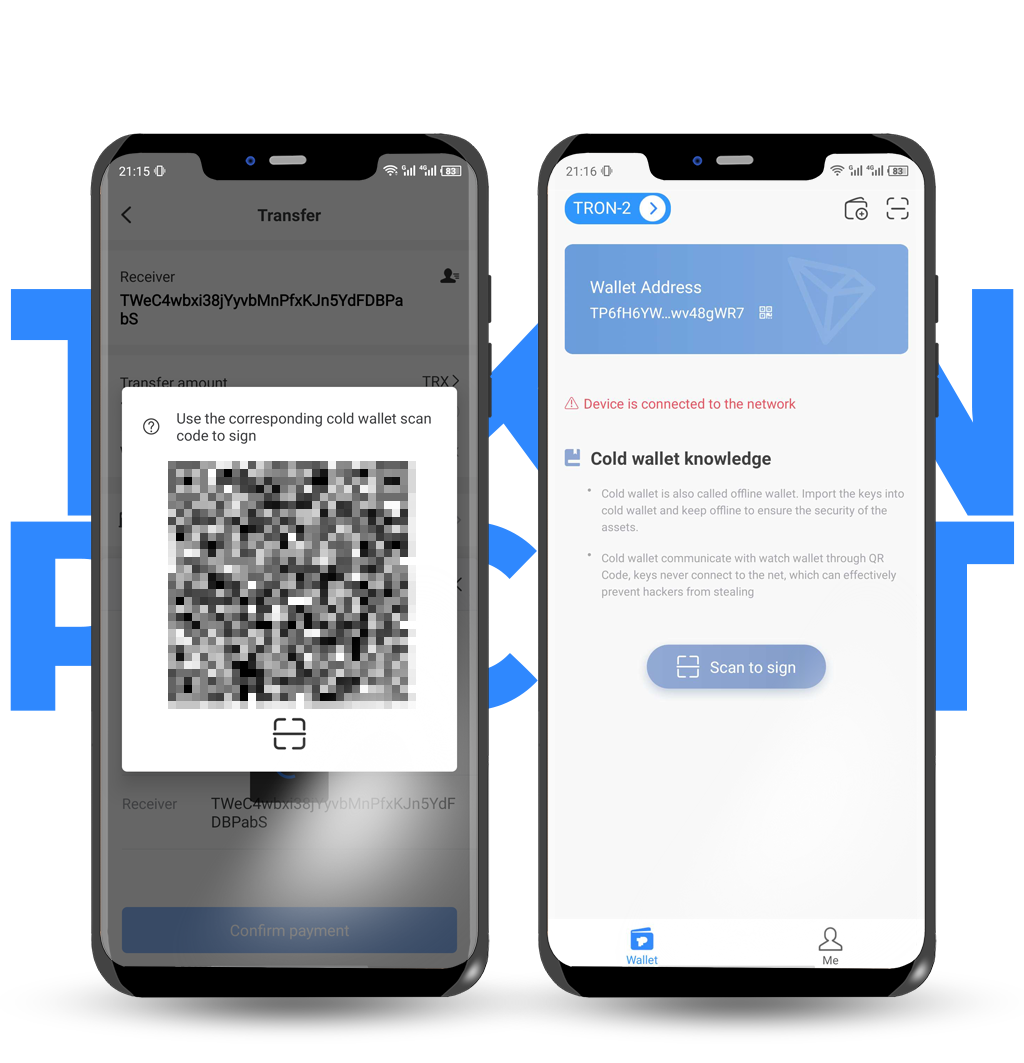Blockchain and wallets have been constantly evolving for over a decade, and their history can be divided into three stages. In the Blockchain 1.0 era, users needed wallets for full node mining and BTC asset management. In the ETH 2.0 era, blockchain wallets are needed for multiple assets management and smart contracts interface. During this stage, wallets like MetaMask that don’t require full node synchronization became popular among users. In the Blockchain 3.0 era, as public chains continued to evolve, wallets correspondingly became more complex and were equipped with more features than ever before . Wallets during this time are not only used to store and manage assets, but served more as a vital service platform for the public chain’s ecosystem. As use cases for blockchain grew, mobile wallets became users’ first choice. Therefore, more and more public chain wallets sprang up like mushrooms, among which TRON wallet is the one that truly stands out.
TRON has always been a popular public chain. With the continuous optimization and improvement of its main network, TRON’s TPS has reached the mark of 10,000, and its public chain performance is also stronger than before, supporting more and more use cases. Through free access and user incentive programs, TRON has invigorated its community. In the past two years, TRON boasted rapid growth and attracted a great number of users and developers through its low cost and solid performance. In terms of DApp user number and transaction volume, TRON has always been in the top 3 among all the public chains.
As a gateway to the TRON ecosystem, TRON wallet is an essential component to TRON public chain. Until this day, TRON never stopped optimizing its features and performance for better user experience. TRON wallets used to provide only basic functionalities including permission management, funds transfer, and voting. But now, they include complex features like fiat exchange, flash swap, and decentralized exchange etc.. TRON wallets also allow users to enjoy various DApps, mining, DeFi, Staking, and other value-added services. With TRON wallets, users are blessed with a diverse, ever-evolving ecosystem.
Users can sign up free of charge with a Tron account, a string of 34 letters and numbers. Different from customized account names for EOS and IOST, Tron will generate a random account for users.
When creating an account, users will only have to set the wallet name and log-in password, and write down the private key. Simple as that.
**A new account needs to be activated before using. To activate a new account, the owner needs to transfer any number of TRX into it. **
Tron wallet creation page in TokenPocketIf the user already has a TRON wallet, he or she can add the new one through the "private key import" in the TP wallet. The wallet can be added either through entering the private key or scanning the QR code.
Bandwidth Points
Bandwidth Points (BP) is the number of bytes that can be used by an account to conduct transactions. For every 24 hours, TRON network grants every account 5000 complimentary Bandwidth Points, and doing extra transactions will require freezing TRX to generate additional bandwidth points. Of course, users without bandwidth can still access to all the features. They system will consume a certain number of TRX as handling fees to make sure the account functions normally. Unactivated new TRON accounts will need other addresses to transfer any amount of TRX into them. Then the user will be able to view his/her current energy and bandwidth points on the resource page.
Energy
Energy is the resource consumed by TRON Network’s CPU. Like bandwidth, it can be obtained through freezing TRXs. However, there won’t be free Energy distributed to each account by TRON. Users will consume Energy when using DApps. Like BP, Energy consumption can also be paid in TRX directly.
Freezing TRON
BP and Energy can be obtained through freezing TRX, and they can also be delegated to other addresses. In this situation, the delegating account owns the frozen TRX and the corresponding votes while the delegated account is entitled to the resources gained. Like the common form of freezing, the delegated resources will be frozen for three days.
TRON Unfreezing
Tokens can be unfrozen three days after freezing. Upon unfreezing, the corresponding resources will be removed and the unfrozen TRX can be traded. Please note that once the TRX is unfrozen, the corresponding TRON Power will be deducted, meaning that the votes for a certain node will be removed.
TronIX, known as TRX, is a MainNet token based on the Tron Protocol issued by TRON Foundation.
TRX is the basic unit of accounts on the Tron blockchain. The value of all other tokens derives from that of Tron. TRX is also a natural medium currency for all TRC-based tokens. TRX connects the entire Tron ecosystem, with abundant application scenarios that power transactions and applications on the chain.
Every time a super representative produces a block, it will be rewarded 16 TRX. The 27 super representatives take turns to produce blocks every 3 seconds. The annual block producing reward is 168,192,000 TRX in total.
Every time a super representative produces a block, the 127 super representatives and partners will share 160 TRX proportional to the votes they get. That is 1152000 TRX in every 6 hours, and 1,681,920,000 TRX annually. After commission is deducted, voting rewards received by super representatives and partners will be distributed to general users proportional to the votes they cast.
TRX can be used for voting, deploying smart contracts, etc. Users do not have to pay service fee for TRX transfer, as a certain amount of TRX will be burned according to the bandwidth consumed.
There are three ways to get TRX: Token-to-token Flash Swap, purchase with fiat currencies, and through exchanges.
Get TRX from Exchanges
As a mainstream chain token, TRX is now supported by nearly all major exchanges, such as Binance, Huobi, OKEx.
Flash Swap
Flash Swap enables users to exchange other tokens for TRX. Unlike the orderbook model adopted by most exchanges, Flash Swap utilizes a ‘bank’model where token swap can be done in seconds.
Purchase with Fiat Currencies
Users can purchase TRX with fiat money in TokenPocket. The TRX will be directly transferred into the Tron wallet after purchase.
TRON network supports two types of token: TRC-20 token issued by smart contract, and TRC-10 token issued by system contract.
TRC-10 is a technical token standard supported by the Tron blockchain natively without the Tron Virtual Machine (TVM). Every account is capable of issuing tokens at the expense of 1024 TRX. Users can lock their tokens up separately. To issue tokens, the issuer needs to specify a token name, total capitalization, the exchange rate to TRX, circulation duration, description, website, maximum bandwidth points consumption per account, total bandwidth points consumption, and token freezing.
TRC-20 is a technical contract standard on the Tron blockchain for issuing tokens, and contracts that comply with the standard are deemed TRC-20 contracts. Thus the standard shows what functions and events are defined in a certain TRC-20 contract, which facilitates the implementation of TRC-20 token exchanges on wallets and exchanges
Currently, most TRON wallets, like TP Wallet and TronLink, support TRC-10 and TRC-20 protocols.
TRC20-USDT is the USD-pegged stablecoin issued by Tether on the TRON network. Its issuance, holding and transfer on Tron will be completed via smart contract, with a completely free and transparent process, zero transfer fee, and instant delivery. It also enables interoperability with Tron-based protocols and Decentralised Applications (DApps) while allowing users to transact and exchange fiat pegged currencies across the TRON Network.
In terms of transaction fee, TRC20-USDT can offer free transactions when an account has enough energy. According to major exchanges, USDT based on Omni protocol has the highest withdrawal fee, costing users 4 to 10 dollars for one transaction, whereas ERC-20 USDT requires a transaction fee of 1 to 5 dollars. In comparison, TRC-20 needs no transaction fee.
In terms of the confirmation speed of transactions, TRC-20 USDT has the advantage of the third-gen public chains. TPS of TRON network reaches tens of thousands, and only takes seconds to confirm a transaction, way better than Omni (taking minutes to days to confirm one transaction) and ERC20 (taking minutes to hours). Fast confirmation can meet users’ various needs, avoid network congestion, and protect users’ interests.
Thanks to its advantages, TRON-USDT has attracted a huge number of users and is now supported by multiple exchanges, such as Binance, Huobi, Okex, and KuCoin.
TokenPocket fully supports TRON-USDT, where users can swap between TRON-USDT and USDT on other protocols, or other tokens. Users can also deposit, transfer, and purchase USDT in TP centralized wallet, and make transfers, receive payment and check code details in TP decentralized wallet.
For more TRC-20 USDT information:https://tron.network/usdt。
USDJ is a new currency generated through decentralized smart contracts on the TRON network. Anyone can pledge TRX as collateral to generate USDJ. USDJ enters into free circulation as any other cryptocurrency does once generated. It is pegged to the US dollar through Collateralized Debt Positions (CDPs) and autonomous feedback mechanisms.
JUST is a decentralized lending platform that adopts two token systems: USDJ and JST. USDJ, pegged to USD at 1:1, can be generated by collateralizing TRX in the CDP portal of JUST. JST is used for interest payment, platform maintenance, network governance through voting and other activities on JUST.
JUST-DeFi is supported by TokenPocket, where users can get USDJ by collateralizing TRX.
BitTorrent is a pioneering distributed communication protocol invented by Bram Cohen in 2001. As a peer-to-peer protocol, it facilitates the transfer of large, highly demanded files, eliminating the need for a trusted central server.
BitTorrent Token (BTT) is a TRON TRC-10 cryptographic token introduced by BitTorrent Inc. BTT acts as a general purpose mechanism for transacting in computing resources shared between BitTorrent clients and a liquid market of service requesters and service providers. BTT is the unit which denominates transactions for the provision of services in the BTT-enabled BitTorrent ecosystem. It is made available as a divisible token, allowing for granular pricing on the services and requests in the liquid market.
What can BTT do?: (1)Run with token wallets and bidding engines to allow users to give or accept a price. (2)Users can buy and download content from creators with BTT. (3)Users can reward performers with BTT during the livestreaming. (4)BTT can be used for fundraising where smart contracts can be used to host project funds. (5)Pay BTT for paid services like storage, computing, resource provision, and content distribution.
DLive is the largest live streaming media community on blockchain supported by BitTorrent and Tron Foundation, where users can explore games and channels and gain rewards by watching content on the platform.
25% of the daily donation and subscription revenue of DLive is used as BTT staking rewards, which is unique to DLive. This feature is to incentivize people to participate in the development of the platform.
Users can enter DLive and gain BTT staking rewards through TokenPocket.
On DLive BTT staking page, click “Stake In”to stake BTT and click “Claim Reward” to receive your dividend.
TVM (TRON) is almost completely compatible with EVM (Ethereum) with certain expansion focused on TRON’s unique features. Hence, NFT standards like ERC777 can be seamlessly migrated to Tron.
Developers can issue a TRC-10 token through calling the createassetissue interface or a TRC-20 token through TRC-20 contract deployment to TRON network.
Tokens based on Tron can be traded in Tron’s decentralized exchanges. Among all decentralized exchanges on TRON, Poloni DEX, TronTrade, Nexdex-Tron are three major ones. Users can enter these dexs through decentralized TRON wallets, like TokenPocket.
(1)Poloni DEX PoloniDex is a Tron-based decentralized trading platform under Poloniex. Established in 2014, Poloniex is a global leading digital asset trading platform registered in Seychelles. Since Poloniex was founded, its safe and efficient services have been recognized by users, and its real transaction volume has long been ranked among the top 3 in the world. The original TrollBox system allows users to get a more interesting trading experience. The vision of Poloniex is to reconstruct the global trust system, let transactions reach every corner, liberate value, and make value flow freely.
(2)TronTrade Trontrade is a decentralized trading platform based on Tron, where you can easily buy and sell various TRC10 and TRC20 cryptocurrencies. TronTrade's goal is to become the safest, most user-friendly and most reliable decentralized exchange for TRC10 and TRC20 tokens.
(3)Newdex-Tron: the world's leading decentralized exchange Newdex was established on August 8, 2018 and first released on the EOS public chain. In August 2019, apart from EOS public chain, Newdex began to support the TRON public chain. Newdex is dedicated to building a multi-chain and cross chain decentralized trading platform.
The most basic functionality of a TRON wallet is to transfer and receive tokens. Normally, a transaction doesn’t cost any fee, but will consume BP (bandwidth resource), which can be generated by freezing TRX.
● Basic transfer (between TRON accounts)
Basic transfer refers to token transfer between two independent TRON accounts, which can be done by entering the recipient’s address and the transfer amount.
● Transfer from an exchange to a TRON account (wallet address)
This refers to TRX withdrawal from an exchange to a Tron account, which can be done by entering the TRON wallet address and the withdrawal amount.
● Transfer from a TRON account (wallet address) to an exchange
This can be done by entering the exchange address and deposit amount.
To better meet users’ needs for transferring and receiving tokens, TRON wallets provide direct transfer, address book transfer, and QR code transfer.
●Direct transfer
Direct transfer refers to transfers among Tron addresses, where users need to enter the recipient’s TRON account and transfer amount.
● Address book transfer
The address book is like a contact list on our mobile phone. After an address book is created, you can choose the TRON address from the book to transfer tokens to. It can come really handy if you have a frequent recipient, and reduce risk of entering a wrong account.
● QR code transfer
TRX transfer can be done through scanning the recipient’s QR code. Additionally, recent recipients will be found in “Recent”. By clicking on “Recent”, you will see the most recent TRON address you made a transfer to on the transfer page. This comes in handy if you have a frequent recipient.
Transfer through an address book, scanning QR codes, or recent transfer can all help prevent errors of manual typing and the loss incurred.
● Transfer with observe wallets and cold wallets
If a wallet always has a large amount of deposit and often needs to transfer, transferring through the combination of an observe wallet and cold wallet is recommended to ensure the safety of assets. A cold wallet can isolate a user's private key and mnemonic phrase from the internet, which resembles a mobile phone without any connection, to almost 100 percent ensure the safety of the assets. An observe wallet is a wallet that can observe the changes of assets in another address. It doesn’t require the import of the private key. Users only need to input the account or public key. It can help users to check the transaction information.
To transfer, users need to operate in the observe wallet. What’s different from a normal transfer is that a QR code will pop up when granting permission. Then, scan the QR code with the cold wallet and another QR code will be generated. Scan the QR code with the observe wallet and complete the entire process.
In a TRON wallet, users can receive tokens from others and withdraw tokens from an exchange.
● Address
On the Receive page, users can copy their address with one click to withdraw tokens from an exchange or receive tokens from others in a safe and easy way.
● QR code
Similar to how users can make transfers by scanning the recipient QR code, they can also receive tokens by having token senders scan their QR code.
Super representatives: Super representatives are responsible for producing blocks and approving transactions. In return, they can receive voting and block rewards and vote for proposals raised by the TRON committee.
Super partner: eligible for voting rewards.
Voter: TRON community members who participate in voting. Reward distribution ratio: the percentage of the rewards for voters out of the total rewards gained by the super representatives and super partners.
Each user can cast one or multiple votes for multiple candidates.
Before voting, the voter needs to freeze a certain amount of TRX to gain TRON Power (TP). Frozen TRX won’t go into circulation and cannot be transferred.
TP is calculated in the following way: freeze 1 TRX to get 1 TP, and 1 TP is 1 vote.
One voting round lasts for 6 hours. The voting results and node list are updated on 0:00, 6:00, 12:00, and 18:00 (UTC) every day. The votes cast will be updated in the next voting round.
Users can withdraw all or part of their votes from a node. Only tokens that have been freezed for at least 3 days can be unfreezed. Frozen tokens can be unfreezed for Energy or bandwidth based on the resource they have been freezed to obtain. Note that all TRX freezed to obtain that resource should have been freezed for at least 3 days.
After unfreezing, all TP and resources (bandwidth or Energy) gained will be removed.
After unfreezing, the TP which has been used for voting will also be removed. You need to re-freeze TRX for TP to vote again so that the votes you have cast won’t be affected
In the TRON network, any TRX holder can apply to be an SR candidate and are likely to become a super representative or a super partner. Each TRX holder can vote for SR candidates. The top 27 most-voted candidates become super representatives, and the 28-127th become super partners. SRs are responsible for producing blocks and packing transactions, and can receive corresponding voting and block rewards in return. SR candidates do not produce blocks or pack transactions, and are only eligible for voting rewards.
The reward distribution ratio for voters varies depending on the super representative (SR).
Calculation of rewards:
Theoretically, TRON SRs produce a total of 28792 blocks every day. Each SR produces 1066 blocks daily. The SR commission ratio of TRON is 20%. Block rewards for each SR are 16. Voting rewards are 160. Total votes are 22,382,488,418 (real-time).
SR daily total reward = (blocks produced by the SR per day _ reward for each block + total blocks produced per day _ votes received by the SR / total votes)
SR commission reward = SR daily total reward * SR commission ratio
Reward distributed to voters = SR daily total reward - SR commision reward
Vote through TRON wallets
On the voting page in a TRON wallet, select the candidate to vote for and the vote amount. This is the easiest and quickest way to cast a vote.
Vote on the website
Go to https://Tronscan.io/, select the node you want to vote for on the voting page and click on “vote”.
The asset collection function supported by the underlying layer of TRON is a piece of good news for multi-account users. Its essence is making transfers from multiple accounts. When users have multiple TRON accounts and each account has a small amount of tokens, the asset collection function can be used to group the assets into one account, which can facilitate asset management.
Users need to import all accounts into the wallet. If all accounts share the same password, the user only needs to grant the permission once; otherwise, the permission needs to be granted multiple times.
The whitelist function provides great convenience for users to better take advantage of DApps. Normally, when exploring DApps on TRON, users need to enter the password every time they interact with smart contracts. The whitelist feature is to perform authorization without having to input the password for specific smart contract operations in the DApp. Users only need to enter the password once when the whitelist function is turned on.
Blockchain explorer is the main window for looking up blockchain information, and the content recorded in each block can be consulted on the blockchain explorer.
Currently, the commonly used TRON explorer is TronSCAN. Tronscan.io is the first block explorer based on TRON. It not only includes some basic functions of a block explorer, such as search and query transactions, accounts, blocks, nodes, and smart contracts, as well as data gathering and queries on the chain, but also supports token creation. Meanwhile, TronSCAN also has a built-in web wallet and Bancor-based DEX, which enriches the application scenarios of TronSCAN.
Many users have multiple TRON accounts, and the wallet order adjustment function allows users to put the most frequently used wallets in the first places simply by dragging, so that they can switch wallets and manage their assets more conveniently.
The TRON test network is relative to the mainnet. The TRON mainnet refers to a blockchain network that is officially launched and can operate independently, which has real economic value. The TRON testnet is the predecessor of the mainnet and the two have similar functions. TRON testnet is mainly used for swift project iterations and early participation of community members. Community members and supporters of the TRON project participate in various processes on the testnet such as verification and mining, and give feedback; the technical team continues to make corrections and improvements to the mainnet.
The commonly used Tron testnet is TronLIN, which supports the Tron testnet and SUN Network. It is in stable operation and can be used to support project development and iterations, as well as early user participation.
Nile testnet (http://nileex.io) is also a good option, whose code version is consistent with Tron mainnet.
Tron’s official channels include Twitter @Tronfoundation and @justinsunTron.
Users can also get Tron-related information from Tron wallets, like TokenPocket. TokenPocket provides a one-stop reading experience for users, including the latest updates, flash news and articles about Tron.
Tron Wallet is the entrance for TRON community users to TRON DApps, which can meet users' various needs for applications. DApp is the abbreviation of Decentralized Application, which refers to an application developed on blockchains.
Thanks to its excellent performance, security and low cost, TRON public chain has attracted hundreds of community developers to develop, deploy and operate on-chain DApps on it. As of Q1 2020, the total number of DApps on TRON has exceeded 700, with more than 230,000 active users.
Over the past two years, we saw that Tron has worked all the way from building the public chain infrastructure, expanding the ecosystem for the public chain, to developing public-chain based applications. The Tron team holds to the principle of patience and making small but accumulative achievements in the blockchain industry. With hard work, TRON has already gradually outpaced most public chain teams. The future of TRON lies not only in the further improvement of public chain performance, isomorphic and heterogeneous cross-chain, as well as security and privacy enhancement. TRON focuses more on connecting internet products and blockchain services, to build a true Internet of value.
Currently, Tron is a public chain worthy more attention from developers. Based on its good performance and ecosystem, many DApps with high volume of users and transactions have emerged on Tron. TRON’s strong consensus mechanism makes it perform better in TPS than Bitcoin and Ethereum. High TPS guarantees low computation latency, which enables its transaction speed to be on par with existing payment systems. Due to the scalability of the Tron network and its efficient smart contracts, TRON allows various applications to be deployed on it. Tron adopts a design of low computing cost, making it easier for different applications to expand their user base while maintaining its commercial competitiveness.
At present, in terms of contract and transaction experience, TRON has a large advantage over ETH. At the same time, the entry barrier and contract development threshold for new TRON users is almost zero. Tron has an advantage over EOS as its TVM supports Solidity. In order for developers to better use Tron mainnet, members of the Tron community hereby prepared a guide for TRON developers, providing a complete toolkit covering contracts development, testing, deployment and interfaces. Please check TRON Developer Center at https ://cn.developers.Tron.network/.
Meanwhile, TRON wallets also provide tools for developers to facilitate the building of the TRON ecosystem.
Take TokenPocket wallet as an example. TP wallet provides Android and iOS mobile SDKs for TRON developers. Developers can use SDK to call TP wallet to authorize login to wallet account and perform contract functions. TP Wallet's internal Webview has a built-in TronWeb object. Users can directly enter the URL in the Dapp browser in the wallet to develop and test various DAPPs developed based on TRON, and perform functions such as invoking authorized signatures in the Dapp browser in the TP wallet.
In short, TRON, thanks to its good performance and free daily resources, provides the possibility for the birth and mass use of more sophisticated DApps. At the same time, wallets provide TRON developers with a handy development and debugging tool. Both combined contribute to a better public chain for applications.
Related wallet protocols and SDK links:
https://github.com/TP-Lab/TokenPocket-Protocol
https://github.com/TP-Lab/mobile-sdk
https://github.com/TP-Lab/tp-js-sdk
















https://chrome.google.com/webstore/detail/tronlink%EF%BC%88%E6%B3%A2%E5%AE%9D%E9%92%B1%E5%8C%85%EF%BC%89/ibnejdfjmmkpcnlpebklmnkoeoihofec



TRON website:https://tron.network/
Wechat official account:波场 TRON
Weibo:波场 TRON 区块链
Twitter: https://twitter.com/Tronfoundation
Telegram: https://t.me/tronnetworkEN
GitHub: https://github.com/tronprotocol
Medium: https://medium.com/tron-foundation
